Genomic Insights and Antimicrobial Potential of Newly Streptomyces cavourensis Isolated from a Ramsar Wetland Ecosystem
Abstract
:1. Introduction
2. Materials and Methods
2.1. Actinomycete Isolation
2.2. Phenotypic and Physiological Characterization
2.3. MALDI-TOF MS Identification
2.4. DNA Extraction, 16SrRNA Gene Sequencing and Phylogenetic Analysis
2.5. Antimicrobial Testing Activity of Streptomyces sp. ACT158
2.6. Genome Sequencing, Assembly, Gene Prediction and Functional Annotation
2.7. Phylogenomics, and Comparative Genome Analysis
3. Results
3.1. Phenotypical Characterization of ACT158
3.2. MALDITOF and 16SrRNA-Based Analysis
3.3. Genome Assembly, Annotation and Functional Analysis
3.4. Similarity of Whole Genomes
3.5. Comparative Genome Analysis
3.6. Antimicrobial Activity of ACT158
3.7. Analysis of Secondary Metabolic Biosynthetic Gene Clusters
4. Discussion
5. Conclusions
Supplementary Materials
Author Contributions
Funding
Institutional Review Board Statement
Informed Consent Statement
Data Availability Statement
Conflicts of Interest
References
- Rani, A.; Saini, K.C.; Bast, F.; Mehariya, S.; Bhatia, S.K.; Lavecchia, R.; Zuorro, A. Microorganisms: A potential source of bioactive molecules for antioxidant applications. Molecules 2021, 26, 1142. [Google Scholar] [CrossRef] [PubMed]
- Selim, M.S.M.; Abdelhamid, S.A.; Mohamed, S.S. Secondary metabolites and biodiversity of actinomycetes. J. Genet. Eng. Biotechnol. 2021, 19, 72. [Google Scholar] [CrossRef] [PubMed]
- Alam, K.; Mazumder, A.; Sikdar, S.; Zhao, Y.M.; Hao, J.; Song, C.; Li, A.; Wang, Y.; Sarkar, R.; Islam, S.; et al. Streptomyces: The biofactory of secondary metabolites. Front. Microbiol. 2022, 13, 968053. [Google Scholar] [CrossRef] [PubMed]
- Komaki, H. Recent progress of reclassification of the genus Streptomyces. Microorganisms 2023, 11, 831. [Google Scholar] [CrossRef]
- Shepherdson, E.M.; Elliot, M.A. Cryptic specialized metabolites drive Streptomyces exploration and provide a competitive advantage during growth with other microbes. Proc. Natl. Acad. Sci. USA 2022, 119, e2211052119. [Google Scholar] [CrossRef]
- Benhadj, M.; Gacemi-Kirane, D.; Menasria, T.; Guebla, K.; Ahmane, Z. Screening of rare actinomycetes isolated from natural wetland ecosystem (Fetzara Lake, northeastern Algeria) for hydrolytic enzymes and antimicrobial activities. J. King Saud. Univ. Sci. 2019, 31, 706–712. [Google Scholar] [CrossRef]
- Antonopoulos, V.; Hernandez, M.; Arias, M.; Mavrakos, E.; Ball, A. The use of extracellular enzymes from Streptomyces albus ATCC 3005 for the bleaching of eucalyptus kraft pulp. Appl. Microbiol. Biotechnol 2001, 57, 92–97. [Google Scholar]
- Benhadj, M.; Metrouh, R.; Menasria, T.; Gacemi-Kirane, D.; Slim, F.Z.; Ranque, S. Broad-spectrum antimicrobial activity of wetland-derived Streptomyces sp. ActiF450. EXCLI J. 2020, 19, 360. [Google Scholar]
- LPSN (List of Prokaryotic Names with Standing in Nomenclature). Available online: https://lpsn.dsmz.de/genus/streptomyces (accessed on 20 December 2024).
- Zaatout, N.; Al-Mustapha, A.I.; Bouaziz, A.; Ouchene, R.; Heikinheimo, A. Prevalence of AmpC, ESBL, and colistin resistance genes in Enterobacterales isolated from ready-to-eat food in Algeria. Braz. J. Microbiol. 2023, 54, 2205–2218. [Google Scholar] [CrossRef]
- Boukoucha, M.; Menasria, T.; Bouguerra, N. Phenotypic characterization and genotypic subtyping of Salmonella enterica Serovars enteritidis and Gallinarum isolated from human and poultry-related samples. Food Biotechnol. 2018, 32, 206–221. [Google Scholar] [CrossRef]
- Menasria, T.; Monteoliva-Sánchez, M.; Benhadj, M.; Benammar, L.; Boukoucha, M.; Aguilera, M. Unraveling the enzymatic and antibacterial potential of rare halophilic actinomycetes from Algerian hypersaline wetland ecosystems. J. Basic Microbiol. 2022, 62, 1202–1215. [Google Scholar] [CrossRef] [PubMed]
- Soldatou, S.; Eldjárn, G.H.; Ramsay, A.; Van Der Hooft, J.J.; Hughes, A.H.; Rogers, S.; Duncan, K.R. Comparative metabologenomics analysis of polar actinomycetes. Mar. Drugs 2021, 19, 103. [Google Scholar] [CrossRef] [PubMed]
- Kim, J.H.; Lee, N.; Hwang, S.; Kim, W.; Lee, Y.; Cho, B.-K. Discovery of novel secondary metabolites encoded in actinomycete genomes through coculture. J. Indust. Microbiol. Biotechnol. 2021, 48, kuaa001. [Google Scholar] [CrossRef] [PubMed]
- Lee, N.; Hwang, S.; Kim, J.; Cho, S.; Palsson, B.; Cho, B.K. Mini review: Genome mining approaches for the identification of secondary metabolite biosynthetic gene clusters in Streptomyces. Comput. Struct. Biotechnol. J. 2020, 18, 1548–1556. [Google Scholar] [CrossRef]
- Menasria, T.; Monteoliva-Sánchez, M.; Benammar, L.; Benhadj, M.; Ayachi, A.; Hacène, H.; Aguilera, M.; Gonzalez-Paredes, A. Culturable halophilic bacteria inhabiting Algerian saline ecosystems: A source of promising features and potentialities. World J. Microbiol. Biotechnol. 2019, 35, 132. [Google Scholar] [CrossRef]
- Menasria, T.; Aguilera, M.; Hocine, H.; Benammar, L.; Ayachi, A.; Bachir, A.S.; Monteoliva-Sánchez, M.; Dekak, A. Diversity and bioprospecting of extremely halophilic archaea isolated from Algerian arid and semi-arid wetland ecosystems for halophilic-active hydrolytic enzymes. Microbiol. Res. 2018, 207, 289–298. [Google Scholar] [CrossRef]
- Benhadj, M.; Gacemi-Kirane, D.; Toussaint, M.; Hotel, L.; Bontemps, C.; Duval, R.E.; Leblond, P.; Aigle, B. Diversity and antimicrobial activities of Streptomyces isolates from Fetzara Lake, north eastern Algeria. Ann. Biol. Clin. 2018, 76, 81–95. [Google Scholar] [CrossRef]
- Shirling, E.T.; Gottlieb, D. Methods for characterization of Streptomyces species. Int. J. Syst. Evol. 1966, 16, 313–340. [Google Scholar] [CrossRef]
- Gordon, R.E.; Barnett, D.A.; Handerhan, J.E.; Pang, C.H.N. Nocardia coeliaca, Nocardia autotrophica, and the nocardin strain. Int. J. Syst. Evol. Microbiol. 1974, 24, 54–63. [Google Scholar] [CrossRef]
- Cassagne, C.; Normand, A.C.; Bonzon, L.; L’Ollivier, C.; Gautier, M.; Jeddi, F.; Ranque, S.; Piarroux, R. Routine identification and mixed species detection in 6,192 clinical yeast isolates. Med. Mycol. 2016, 54, 256–265. [Google Scholar] [CrossRef]
- Kieser, T.B.M.J.; Bibb, M.J.; Buttner, M.J.; Chater, K.F.; Hopwood, D.A. Practical Streptomyces Genetics. A Laboratory Manual; The John Innes Foundation: Norwich, UK, 2000. [Google Scholar]
- Weisburg, W.G.; Barns, S.M.; Pelletier, D.A.; Lane, D.J. 16S ribosomal DNA amplification for phylogenetic study. J. Bacteriol. 1991, 173, 697–703. [Google Scholar] [CrossRef] [PubMed]
- Yoon, S.H.; Ha, S.M.; Lim, J.; Kwon, S.; Chun, J. A large-scale evaluation of algorithms to calculate average nucleotide identity. Antonie Van Leeuwenhoek 2017, 110, 1281–1286. [Google Scholar] [CrossRef] [PubMed]
- Larkin, M.A.; Blackshields, G.; Brown, N.P.; Chenna, R.; McGettigan, P.A.; McWilliam, H.; Valentin, F.; Wallace, I.M.; Wilm, A.; Lopez, R.; et al. Clustal W and Clustal X version 2.0. Bioinformatics 2007, 23, 2947–2948. [Google Scholar] [CrossRef] [PubMed]
- Andrews, S. FastQC: A Quality Control Tool for High Throughput Sequence Data. 2010. Available online: http://www.bioinformatics.babraham.ac.uk/projects/fastqc/ (accessed on 28 January 2025).
- Antipov, D.; Korobeynikov, A.; McLean, J.S.; Pevzner, P.A. hybridSPAdes: An algorithm for hybrid assembly of short and long reads. Bioinformatics 2016, 32, 1009–1015. [Google Scholar] [CrossRef]
- Tatusova, T.; DiCuccio, M.; Badretdin, A.; Chetvernin, V.; Nawrocki, E.P.; Zaslavsky, L.; Ostell, J.; Lomsadze, A.; Pruitt, K.D.; Borodovsky, M.; et al. NCBI prokaryotic genome annotation pipeline. Nucleic Acids Res. 2016, 44, 6614–6624. [Google Scholar] [CrossRef]
- Aziz, R.K.; Bartels, D.; Best, A.A.; DeJongh, M.; Disz, T.; Edwards, R.A.; Zagnitko, O.; Formsma, K.; Gerdes, S.; Glass, E.M.; et al. The RAST Server: Rapid annotations using subsystems technology. BMC Genom. 2008, 9, 75. [Google Scholar] [CrossRef]
- Overbeek, R.; Olson, R.; Pusch, G.D.; Olsen, G.J.; Davis, J.J.; Disz, T.; Stevens, R.; Edwards, R.A.; Gerdes, S.; Parrello, B.; et al. The SEED and the Rapid Annotation of microbial genomes using Subsystems Technology (RAST). Nucleic Acids Res. 2014, 42, D206–D214. [Google Scholar] [CrossRef]
- Kanehisa, M.; Sato, Y.; Morishima, K. BlastKOALA and GhostKOALA. KEGG tools for functional characterization of genome and metagenome sequences. J. Mol. Biol. 2016, 428, 726–731. [Google Scholar] [CrossRef]
- Lombard, V.; Golaconda Ramulu, H.; Drula, E.; Coutinho, P.M.; Henrissat, B. The carbohydrate-active enzymes database (CAZy) in 2013. Nucleic Acids Res 2014, 42, D490–D495. [Google Scholar] [CrossRef]
- Blin, K.; Shaw, S.; Augustijn, H.E.; Reitz, Z.L.; Biermann, F.; Alanjary, M.; Weber, T.; Fetter, A.; Terlouw, B.R.; Metcalf, W.W.; et al. antiSMASH 7.0: New and improved predictions for detection, regulation, chemical structures and visualisation. Nucleic Acids Res. 2023, 51, W46–W50. [Google Scholar] [CrossRef]
- Grant, J.R.; Enns, E.; Marinier, E.; Mandal, A.; Herman, E.K.; Chen, C.Y.; Stothard, P.; Graham, M.; Van Domselaar, G. Proksee: In-depth characterization and visualization of bacterial genomes. Nucleic Acids Res. 2023, 51, W484–W492. [Google Scholar] [CrossRef] [PubMed]
- Meier-Kolthoff, J.P.; Göker, M. TYGS is an automated high-throughput platform for state-of-the-art genome-based taxonomy. Nat. Commun. 2019, 10, 2182. [Google Scholar] [CrossRef] [PubMed]
- Meier-Kolthoff, J.P.; Auch, A.F.; Klenk, H.P.; Göker, M. Genome sequence-based species delimitation with confidence intervals and improved distance functions. BMC Bioinform. 2013, 14, 60. [Google Scholar] [CrossRef] [PubMed]
- Lee, I.; Ouk Kim, Y.; Park, S.C.; Chun, J. OrthoANI: An improved algorithm and software for calculating average nucleotide identity. Inter. J. Syst. Evol. Microbiol. 2016, 66, 1100–1103. [Google Scholar] [CrossRef]
- Sun, J.; Lu, F.; Luo, Y.; Bie, L.; Xu, L.; Wang, Y. OrthoVenn3: An integrated platform for exploring and visualizing orthologous data across genomes. Nucleic Acids Res. 2023, 51, W397–W403. [Google Scholar] [CrossRef]
- Del Carratore, F.; Hanko, E.K.; Breitling, R.; Takano, E. Biotechnological application of Streptomyces for the production of clinical drugs and other bioactive molecules. Curr. Opin. Biotechnol. 2022, 77, 102762. [Google Scholar] [CrossRef]
- Ouchene, R.; Zaatout, N.; Suzuki, M.T. An Overview on Nocardiopsis Species Originating From North African Biotopes as a Promising Source of Bioactive Compounds and In Silico Genome Mining Analysis of Three Sequenced Genomes. J. Basic Microbiol. 2024, 64, e2400046. [Google Scholar] [CrossRef]
- Benammar, L.; Menasria, T.; Dibi, A.R. Deciphering the geochemical influences on bacterial diversity and communities among two Algerian hot springs. Environ. Sci. Pollut. Res. 2024, 31, 44848–44862. [Google Scholar] [CrossRef]
- Sarmiento-Tovar, A.A.; Silva, L.; Sanchez-Suarez, J.; Diaz, L. Streptomyces-derived bioactive pigments: Ecofriendly source of bioactive compounds. Coatings 2022, 12, 1858. [Google Scholar] [CrossRef]
- Bentley, S.D.; Chater, K.F.; Cerdeño-Tárraga, A.M.; Challis, G.L.; Thomson, N.R.; James, K.D.; Hopwood, D.A.; Harris, D.E.; Quail, M.A.; Kieser, H.; et al. Complete genome sequence of the model actinomycete Streptomyces coelicolor A3. Nature 2002, 417, 141–147. [Google Scholar] [CrossRef]
- Ouchene, R.; Intertaglia, L.; Zaatout, N.; Kecha, M.; Suzuki, M.T. Selective isolation, antimicrobial screening and phylogenetic diversity of marine actinomycetes derived from the Coast of Bejaia City (Algeria), a polluted and microbiologically unexplored environment. J. Appl. Microbiol. 2022, 132, 2870–2882. [Google Scholar] [CrossRef] [PubMed]
- Dekak, A.; Menasria, T.; Benhizia, Y.; Chenchouni, H. Endophytic passenger bacteria associated with Genista cinerea nodules growing in North African drylands. Rhizosphere 2020, 14, 100205. [Google Scholar] [CrossRef]
- Abdelgalil, S.A.; Soliman, N.A.; Abo-Zaid, G.A.; Abdel-Fattah, Y.R. Bioprocessing strategies for cost-effective large-scale production of bacterial laccase from Lysinibacillus macroides LSO using bio-waste. Inter. J. Environ. Sci. Technol. 2020, 19, 1633–1652. [Google Scholar] [CrossRef]
- Singhania, R.R.; Ruiz, H.A.; Awasthi, M.K.; Dong, C.D.; Chen, C.W.; Patel, A.K. Challenges in cellulase bioprocess for biofuel applications. Renew. Sustain. Energy Rev. 2021, 151, 111622. [Google Scholar] [CrossRef]
- Farooq, M.A.; Ali, S.; Hassan, A.; Tahir, H.M.; Mumtaz, S.; Mumtaz, S. Biosynthesis and industrial applications of α-amylase: A review. Arch. Microbiol. 2021, 203, 1281–1292. [Google Scholar] [CrossRef]
- Naveed, M.; Nadeem, F.; Mehmood, T.; Bilal, M.; Anwar, Z.; Amjad, F. Protease—A versatile and ecofriendly biocatalyst with multi-industrial applications: An updated review. Catal. Lett. 2021, 151, 307–323. [Google Scholar] [CrossRef]
- Vu, H.N.T.; Nguyen, D.T.; Nguyen, H.Q.; Chu, H.H.; Chu, S.K.; Chau, M.V.; Phi, Q.T. Antimicrobial and cytotoxic properties of bioactive metabolites produced by Streptomyces cavourensis YBQ59 isolated from Cinnamomum cassia Prels in Yen Bai Province of Vietnam. Curr. Microbiol. 2018, 75, 1247–1255. [Google Scholar] [CrossRef]
- Wibowo, J.T.; Kellermann, M.Y.; Köck, M.; Putra, M.Y.; Murniasih, T.; Mohr, K.I.; Schupp, P.J.; Wink, J.; Praditya, D.F.; Steinmann, E. Anti-infective and antiviral activity of valinomycin and its analogues from a sea cucumber-associated bacterium, Streptomyces sp. SV 21. Mar. Drugs 2021, 19, 81. [Google Scholar] [CrossRef]
- Riesco, R.; Trujillo, M.E. Update on the proposed minimal standards for the use of genome data for the taxonomy of prokaryotes. Int. J. Syst. Evol. Microbiol. 2024, 74, 006300. [Google Scholar] [CrossRef]
- Mispelaere, M.; De Rop, A.S.; Hermans, C.; De Maeseneire, S.L.; Soetaert, W.K.; De Mol, M.L.; Hulpiau, P. Whole genome–based comparative analysis of the genus Streptomyces reveals many misclassifications. Appl. Microbiol. Biotechnol. 2024, 108, 453. [Google Scholar] [CrossRef]
- Mahato, N.K.; Gupta, V.; Singh, P.; Kumari, R.; Verma, H.; Tripathi, C.; Lal, R.; Rani, P.; Sharma, A.; Singhvi, N.; et al. Microbial taxonomy in the era of OMICS: Application of DNA sequences, computational tools and techniques. Antonie Van Leeuwenhoek 2017, 110, 1357–1371. [Google Scholar] [CrossRef] [PubMed]
- Otani, H.; Udwary, D.W.; Mouncey, N.J. Comparative and pangenomic analysis of the genus Streptomyces. Sci. Rep. 2022, 12, 18909. [Google Scholar] [CrossRef] [PubMed]
- Skinnider, M.A.; Johnston, C.W.; Gunabalasingam, M.; Merwin, N.J.; Kieliszek, A.M.; MacLellan, R.J.; Magarvey, N.A.; Li, H.; Ranieri, M.R.M.; Webster, A.L.H.; et al. Comprehensive prediction of secondary metabolite structure and biological activity from microbial genome sequences. Nat. Commun. 2020, 11, 6058. [Google Scholar] [CrossRef] [PubMed]
- Ejigu, G.F.; Jung, J. Review on the computational genome annotation of sequences obtained by next-generation sequencing. Biology 2020, 9, 295. [Google Scholar] [CrossRef]
- Guan, N.; Li, J.; Shin, H.D.; Du, G.; Chen, J.; Liu, L. Microbial response to environmental stresses: From fundamental mechanisms to practical applications. Appl. Microbiol. Biotechnol. 2017, 101, 3991–4008. [Google Scholar] [CrossRef]
- Chandra, P.; Enespa, S.R.; Arora, P.K. Microbial lipases and their industrial applications: A comprehensive review. Microb. Cell Factories 2020, 19, 169. [Google Scholar] [CrossRef]
- Barber, E.A.; Liu, Z.; Smith, S.R. Organic contaminant biodegradation by oxidoreductase enzymes in wastewater treatment. Microorganisms 2020, 8, 122. [Google Scholar] [CrossRef]
- Huang, X.; Pinto, D.; Fritz, G.; Mascher, T. Environmental sensing in Actinobacteria: A comprehensive survey on the signaling capacity of this phylum. J. Bacteriol. 2015, 197, 2517–2535. [Google Scholar] [CrossRef]
- Qin, S.; Feng, W.W.; Wang, T.T.; Ding, P.; Xing, K.; Jiang, J.H. Plant growth promoting effect and genomic analysis of the beneficial endophyte Streptomyces sp. KLBMP 5084 isolated from halophyte Limonium sinense. Plant Soil 2017, 416, 117–132. [Google Scholar] [CrossRef]
- Undabarrena, A.; Ugalde, J.A.; Seeger, M.; Cámara, B. Genomic data mining of the marine actinobacteria Streptomyces sp. H-KF8 unveils insights into multi-stress related genes and metabolic pathways involved in antimicrobial synthesis. PeerJ 2017, 5, e2912. [Google Scholar] [CrossRef]
- Li, S.; Li, Z.; Pang, S.; Xiang, W.; Wang, W. Coordinating precursor supply for pharmaceutical polyketide production in Streptomyces. Curr. Opin. Biotechnol. 2021, 69, 26–34. [Google Scholar] [CrossRef] [PubMed]
- Cheng, M.; Chen, D.; Parales, R.E.; Jiang, J. Oxygenases as powerful weapons in the microbial degradation of pesticides. Annu. Rev. Microbiol. 2022, 76, 325–348. [Google Scholar] [CrossRef] [PubMed]
- Palazzotto, E.; Weber, T. Omics and multi-omics approaches to study the biosynthesis of secondary metabolites in microorganisms. Curr. Opin. Microbiol. 2018, 45, 109–116. [Google Scholar] [CrossRef] [PubMed]
- Van Bergeijk, D.A.; Terlouw, B.R.; Medema, M.H.; van Wezel, G.P. Ecology and genomics of Actinobacteria: New concepts for natural product discovery. Nat. Rev. Microbiol. 2020, 18, 546–558. [Google Scholar] [CrossRef]
- Vicente, C.M.; Thibessard, A.; Lorenzi, J.N.; Benhadj, M.; Hôtel, L.; Gacemi-Kirane, D.; Aigle, B.; Lespinet, O.; Leblond, P. Comparative genomics among closely related Streptomyces strains revealed specialized metabolite biosynthetic gene cluster diversity. Antibiotics 2018, 7, 86. [Google Scholar] [CrossRef]
- Merradi, M.; Kassah-Laouar, A.; Ayachi, A.; Heleili, N.; Menasria, T.; Hocquet, D.; Cholley, P.; Sauget, M. Occurrence of VIM-4 metallo-β-lactamase-producing Pseudomonas aeruginosa in an Algerian hospital. J. Infect. Dev. Ctries. 2019, 13, 284–290. [Google Scholar] [CrossRef]
- Menasria, T.; Aguilera, M. Genomic diversity of SARS-CoV-2 in Algeria and North African countries: What we know so far and what we expect? Microorganisms 2022, 10, 467. [Google Scholar] [CrossRef]
- Vijayakumar, R.; Panneerselvam, K.; Muthukumar, C.; Thajuddin, N.; Panneerselvam, A.; Saravanamuthu, R. Optimization of antimicrobial production by a marine actinomycete Streptomyces afghaniensis VPTS3-1 isolated from Palk Strait, East Coast of India. Indian J. Microbiol. 2012, 52, 230–239. [Google Scholar] [CrossRef]
- Sánchez, S.; Chávez, A.; Forero, A.; García-Huante, Y.; Romero, A.; Sánchez, M.; Ruiz, B.; Rocha, D.; Sánchez, B.; Ávalos, M.; et al. Carbon source regulation of antibiotic production. J. Antibiot. 2010, 63, 442–459. [Google Scholar] [CrossRef]
- Skarbek, J.D.; Brady, L.R. Streptomyces cavourensis sp. nov.(nom. rev.) and Streptomyces cavourensis subsp. washingtonensis subsp. nov; a chromomycin-producing subspecies. Inter. J. Syst. Evol. Microbiol. 1978, 28, 45–53. [Google Scholar] [CrossRef]
- Xu, W.; Zhang, D.; Si, C.; Tao, L. Antifungal macrolides from Streptomyces cavourensis YY01-17. Chem. Nat. Compd. 2013, 49, 988–989. [Google Scholar] [CrossRef]
- Pan, H.Q.; Yu, S.Y.; Song, C.F.; Wang, N.; Hua, H.M.; Hu, J.C.; Wang, S.J. Identification and characterization of the antifungal substances of a novel Streptomyces cavourensis NA4. J. Microbiol. Biotechnol. 2015, 25, 353–357. [Google Scholar] [CrossRef] [PubMed]
- Robertsen, H.L.; Musiol-Kroll, E.M. Actinomycete-derived polyketides as a source of antibiotics and lead structures for the development of new antimicrobial drugs. Antibiotics 2019, 8, 157. [Google Scholar] [CrossRef] [PubMed]
- Álvarez-Álvarez, R.; Botas, A.; Albillos, S.M.; Rumbero, A.; Martín, J.F.; Liras, P. Molecular genetics of naringenin biosynthesis, a typical plant secondary metabolite produced by Streptomyces clavuligerus. Microb. Cell Factories 2015, 14, 178. [Google Scholar] [CrossRef]
- Martín, J.F.; Liras, P. Comparative molecular mechanisms of biosynthesis of naringenin and related chalcones in actinobacteria and plants: Relevance for the obtention of potent bioactive metabolites. Antibiotics 2022, 11, 82. [Google Scholar] [CrossRef]
- Salehi, B.; Fokou, P.V.T.; Sharifi-Rad, M.; Zucca, P.; Pezzani, R.; Martins, N.; Sharifi- Rad, J. The therapeutic potential of naringenin: A review of clinical trials. Pharmaceuticals 2019, 12, 11. [Google Scholar] [CrossRef]
- Risdian, C.; Mozef, T.; Wink, J. Biosynthesis of polyketides in Streptomyces. Microorganisms 2019, 7, 124. [Google Scholar] [CrossRef]
- Rajesh, T.; Tiwari, M.K.; Thiagarajan, S.; Nair, P.S.; Jeya, M. Type III polyketide synthases: Current state and perspectives. Microb. Technol. Welf. Soc. 2019, 17, 183–200. [Google Scholar]
- Santamaría, R.I.; Martínez-Carrasco, A.; Sánchez de la Nieta, R.; Torres-Vila, L.M.; Bonal, R.; Martín, J.; Díaz, M.; Tormo, R.; Reyes, F.; Genilloud, O. Characterization of actinomycetes strains isolated from the intestinal tract and feces of the larvae of the longhorn beetle Cerambyx welensii. Microorganisms 2020, 8, 2013. [Google Scholar] [CrossRef]
- Krause, J. Applications and restrictions of integrated genomic and metabolomic screening: An accelerator for drug discovery from actinomycetes? Molecules 2021, 26, 5450. [Google Scholar] [CrossRef]
- Al-Quwaie, D.A. The role of Streptomyces species in controlling plant diseases: A comprehensive review. Australas. Plant Pathol. 2024, 53, 1–14. [Google Scholar] [CrossRef]
- Hudson, G.A.; Mitchell, D.A. RiPP antibiotics: Biosynthesis and engineering potential. Curr. Opin. Microbiol. 2018, 45, 61–69. [Google Scholar] [CrossRef] [PubMed]
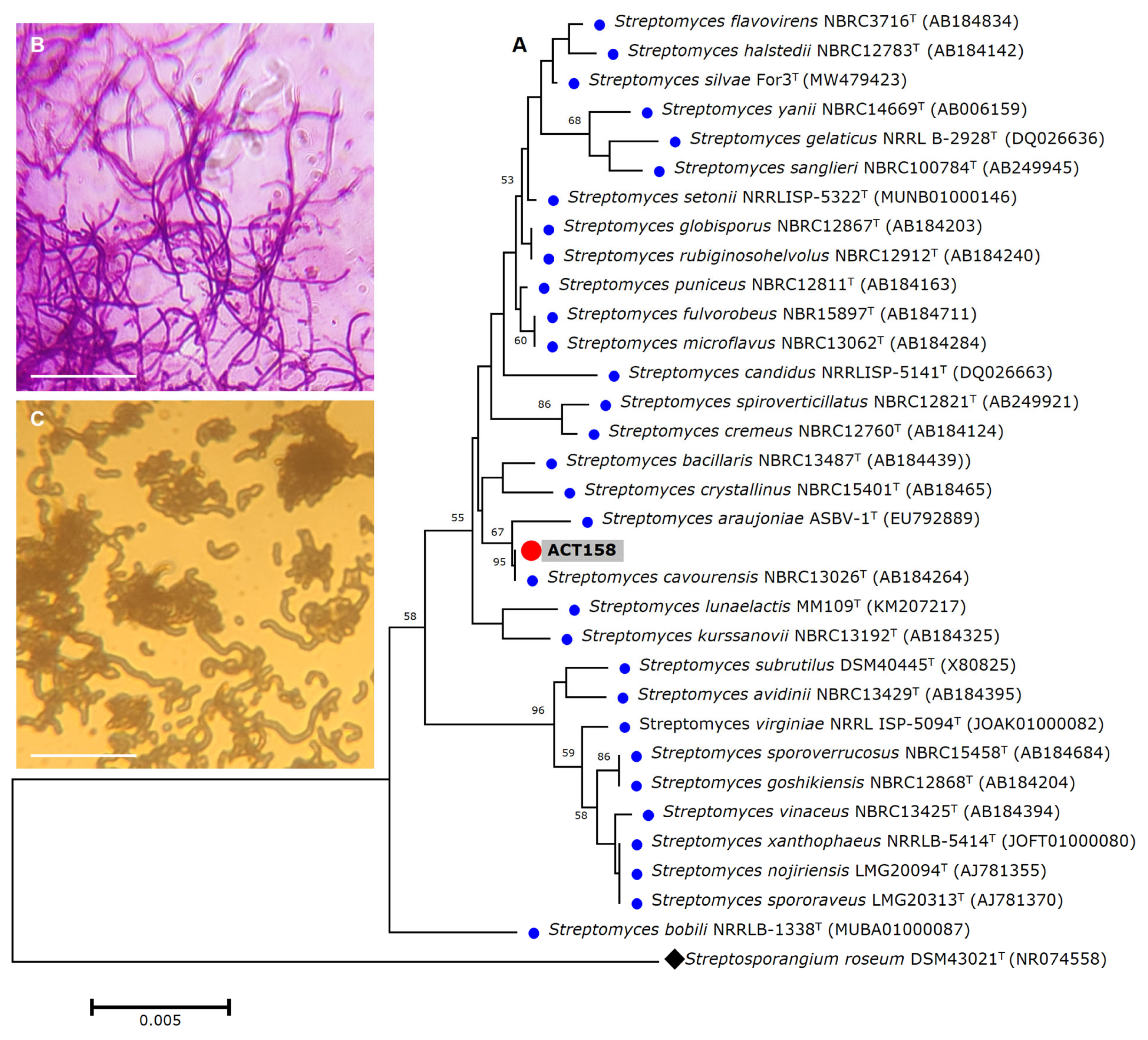

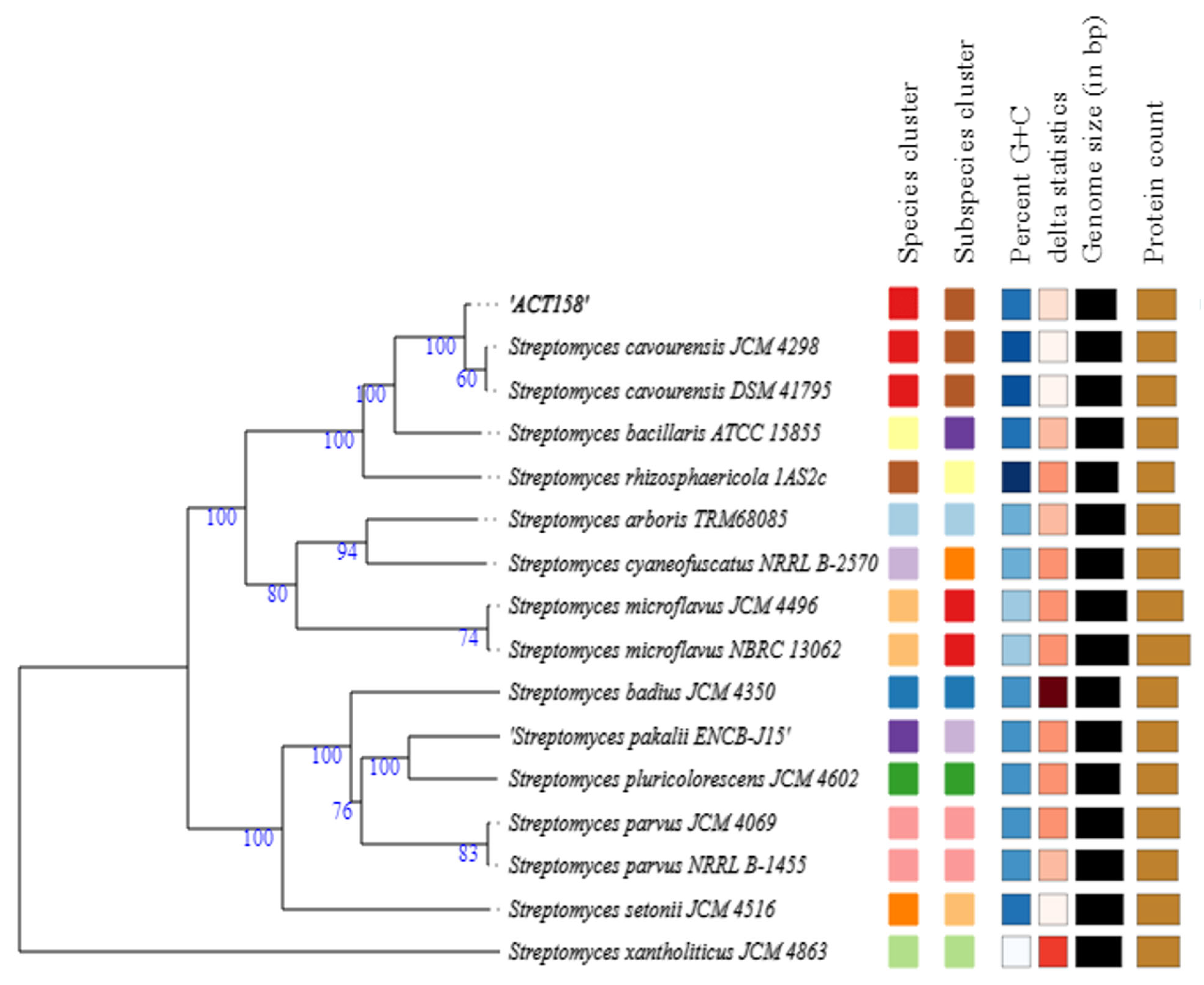


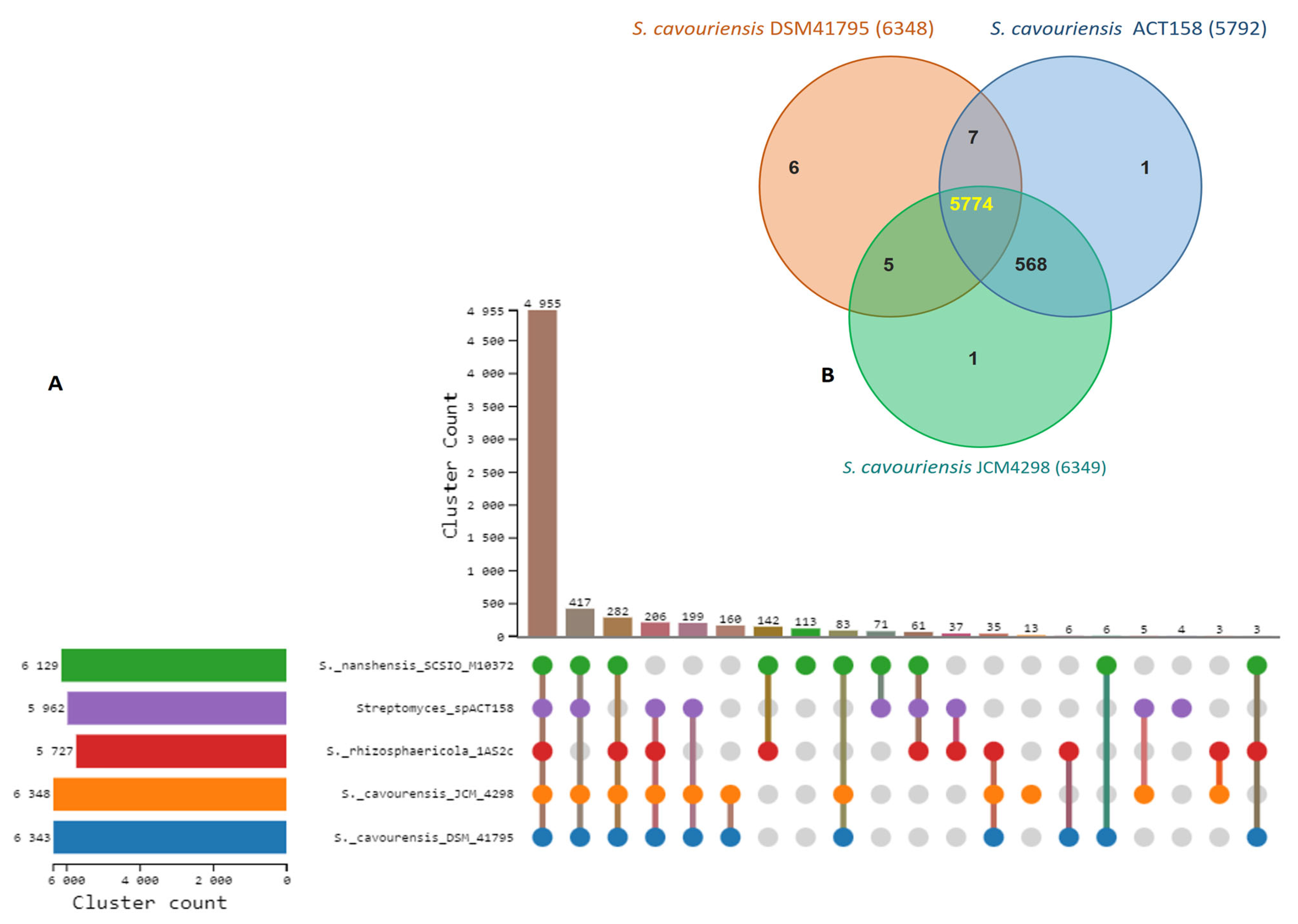
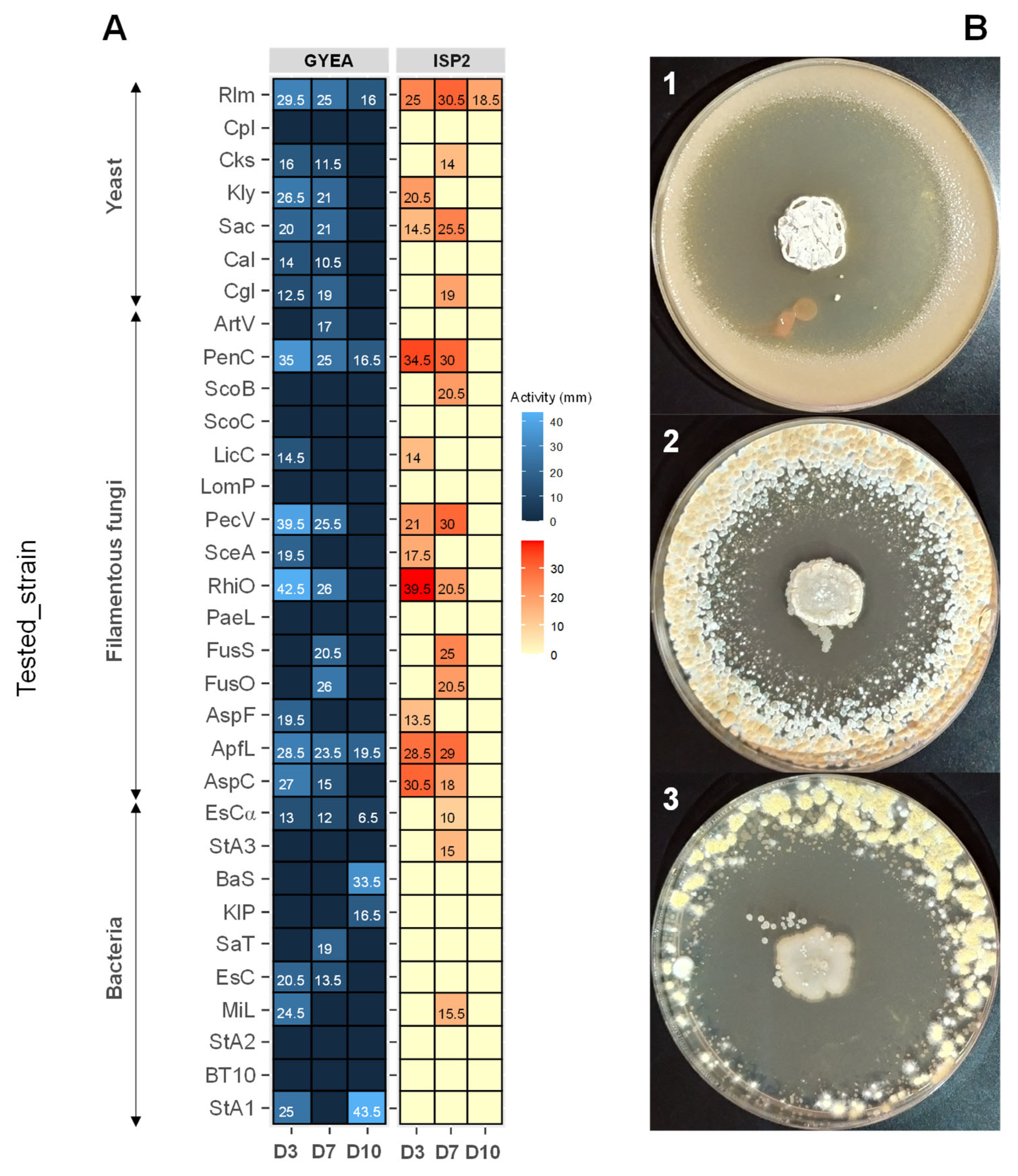
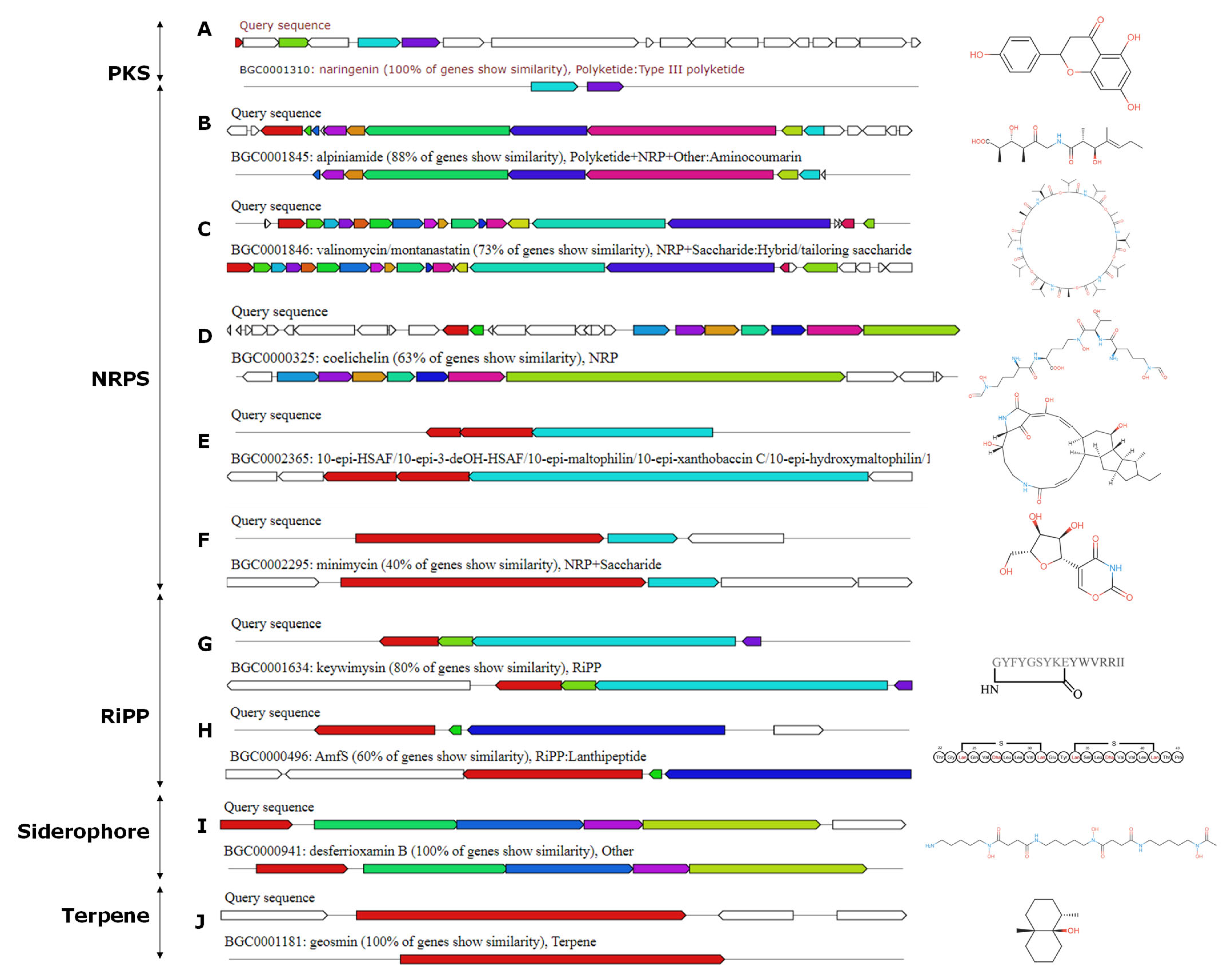
| Characteristics | Values |
|---|---|
| Total Length (bp) | 6,858,072 |
| Number of coding sequences | 6831 |
| GC Content (%) | 71.8% |
| N50 | 8070 |
| Gap Ratio (%) | 0.0% |
| No. of CDSs | 5122 |
| No. of rRNA | 3 |
| No. of tRNA | 54 |
| No. of CRISPRS | 8 |
| Coding Ratio (%) | 70.1% |
| Type | MIBiG Accession | Known Cluster Blast (Biosynthetic Gene) | Similarity | Potential Activity |
|---|---|---|---|---|
| NRPS-T1PKS | BGC0001310 | naringenin | 100% | Antifungal, antiviral |
| NRPS-T1PKS | BGC0002591 | aurachin C | 20% | Antibacterial |
| NRPS-T1PKS | BGC0000236 | kinamycin | 13% | Antitumor |
| NRPS-T1PKS | BGC0000273 | steffimycin D | 16% | Antitumor |
| NRPS-T1PKS | BGC0000028 | bafilomycin B1 | 27% | Antibacterial, antitumor |
| NRPS-T1PKS | BGC0001477 | lydicamycin | 32% | Antibacterial |
| NRPS-T1PKS | BGC0001348 | JBIR-100 | 38% | Antimicrobial |
| NRPS-T1PKS | BGC0001700 | niphimycins C-E | 29% | Antimicrobial |
| NRPS-T2PKS | BGC0000234 | jadomycin | 42% | Antimicrobial |
| NRPS-T3PKS | BGC0000282 | alkylresorcinol | 100% | Antibacterial |
| NRPS | BGC0002001 | crochelin | 16% | Antimicrobial, antitumor |
| NRPS | BGC0001845 | alpiniamide | 88% | Antimicrobial |
| NRPS | BGC0000453 | valinomycin/montanastatin | 73% | Antimicrobial |
| NRPS | BGC0000325 | coelichelin | 63% | / |
| NRPS | BGC0001368 | JBIR-126 | 7% | Antimicrobial |
| NRPS | BGC0000368 | griseobactin | 30% | Antibacterial |
| NRPS | BGC0002441 | o-dialkylbenzene 1 | 12% | / |
| NRPS | BGC0002295 | minimycin | 40% | Antimicrobial |
| NRPS | BGC0002365 | heat-stable antifungal factor | 50% | Antifungal |
| NRPS | BGC0000375 | Indigoidine | 40% | Antibacterial, antioxidant |
| RiPP | BGC0000583 | Linaridin | 20% | Antibacterial |
| RiPP | BGC0000496 | AmfS | 60% | Antimicrobial |
| RiPP | BGC0000606 | lactazole | 22% | Antimicrobial, antitumor |
| RiPP | BGC0001634 | Keywimysin | 80% | Antibacterial |
| Siderophore | BGC0000941 | desferrioxamin B | 100% | Antimicrobial, Iron Chelation |
| butyrolactone | BGC0001778 | showdomycin | 29% | Antimicrobial |
| butyrolactone | BGC0000038 | coelimycin | 8% | Antibacterial |
| Ectoine | BGC0000858 | ectoine | 75% | Osmolyte |
| Terpene | BGC0001181 | Geosmine | 100% | / |
| Terpene | BGC0000664 | Isorenieratene | 42% | / |
| Terpene | BGC0000663 | hopene | 46% |
Disclaimer/Publisher’s Note: The statements, opinions and data contained in all publications are solely those of the individual author(s) and contributor(s) and not of MDPI and/or the editor(s). MDPI and/or the editor(s) disclaim responsibility for any injury to people or property resulting from any ideas, methods, instructions or products referred to in the content. |
© 2025 by the authors. Licensee MDPI, Basel, Switzerland. This article is an open access article distributed under the terms and conditions of the Creative Commons Attribution (CC BY) license (https://creativecommons.org/licenses/by/4.0/).
Share and Cite
Benhadj, M.; Menasria, T.; Zaatout, N.; Ranque, S. Genomic Insights and Antimicrobial Potential of Newly Streptomyces cavourensis Isolated from a Ramsar Wetland Ecosystem. Microorganisms 2025, 13, 576. https://doi.org/10.3390/microorganisms13030576
Benhadj M, Menasria T, Zaatout N, Ranque S. Genomic Insights and Antimicrobial Potential of Newly Streptomyces cavourensis Isolated from a Ramsar Wetland Ecosystem. Microorganisms. 2025; 13(3):576. https://doi.org/10.3390/microorganisms13030576
Chicago/Turabian StyleBenhadj, Mabrouka, Taha Menasria, Nawel Zaatout, and Stéphane Ranque. 2025. "Genomic Insights and Antimicrobial Potential of Newly Streptomyces cavourensis Isolated from a Ramsar Wetland Ecosystem" Microorganisms 13, no. 3: 576. https://doi.org/10.3390/microorganisms13030576
APA StyleBenhadj, M., Menasria, T., Zaatout, N., & Ranque, S. (2025). Genomic Insights and Antimicrobial Potential of Newly Streptomyces cavourensis Isolated from a Ramsar Wetland Ecosystem. Microorganisms, 13(3), 576. https://doi.org/10.3390/microorganisms13030576








